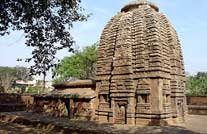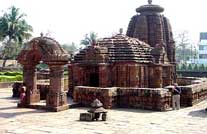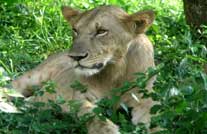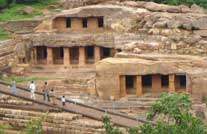|
Home >>
Destination Guide India > Bhubaneswar
DESTINATION
GUIDE INDIA - BHUBANESWAR
ABOUT BHUBANESHWAR
CITY
Bhubaneswar
derives its name from the Sanskrit word Tribhuvaneswara, which
stands for Lord Shiva. The area around Bhubaneswar constituted
the famed kingdom of Kalinga, which was conquered after a
bloody battle by Ashoka, the great Mauryan emperor. Appalled
at the carnage, Ashoka renounced violence and embraced
Buddhism. Around the 1st century BC, under the rule of
Kharvela, Orissa regained its lost glory and Bhubaneswar again
became the center of activities. During this period, monastery
caves were constructed of which Khandgiri and Udaygiri are the
most important. By the 7th century, Hinduism supplemented
Jainism, and Ganga and Kesari kingdoms did a lot for the
development of Orissan culture. Most of the kings who ruled
Orissa constructed beautiful temples. For a better part of its
history, Bhubaneswar remained under the influence of Afghans,
Marathas, and the British (till 1947).
TOURIST
ATTRACTIONS AND ATTRACTIONS - BHUBANESHWAR CITY
Parashurameshvara Temple Built in 650 AD ) is one of the
best example of the Orissa style of temple architecture. This
temple followed very rigid parameters set by the ritualistic
books. The temple has some exquisite carvings and sculpture.
The temple consists of a main garbha griha o r
sanctum with a tower-like roof, referred to in local
terminology as the rekha deul. This tower (only 12.80
meters high, and yet to rival that of the Lingaraja temple at
36.5 meters) is conical in shape and is made up of discrete
horizontal levels which curve inwards as they meet the
pinnacle, surmounted by a cushion-shaped amalaka and a
kalash or pot of ambrosia. The front face of the tower
has prominent arched windows and sculpted motifs. The hall in
front of the tower is rectangular with a two-tiered flat roof
which, as the style progressed, was to give way to more
dramatic many-tiered pyramidal roofs. The walls of the mandap
(locally called jagamohan or pida deul) are
elaborately carved with sculptured panels and lattice windows. r
sanctum with a tower-like roof, referred to in local
terminology as the rekha deul. This tower (only 12.80
meters high, and yet to rival that of the Lingaraja temple at
36.5 meters) is conical in shape and is made up of discrete
horizontal levels which curve inwards as they meet the
pinnacle, surmounted by a cushion-shaped amalaka and a
kalash or pot of ambrosia. The front face of the tower
has prominent arched windows and sculpted motifs. The hall in
front of the tower is rectangular with a two-tiered flat roof
which, as the style progressed, was to give way to more
dramatic many-tiered pyramidal roofs. The walls of the mandap
(locally called jagamohan or pida deul) are
elaborately carved with sculptured panels and lattice windows.
Vaital Deul (800 AD) has a double-storied wagon roof,
which in turn is an influence of the Buddhist cave
architecture. The interior of the temple has the image of
Chamunda (an incarnation of Goddess Kali).
The Rajarani Temple (1100 AD), which derives its name
from the stone known as the Rajarani, was built earlier in
comparison to the impressive Lingaraja. Set amongst
picturesque paddy fields, the relatively small Rajarani temple
is noted for its fascinating female figures portrayed in a
stunning variety of amorous poses and moods.

Mukteshwar Temple(7th-8th century AD) is one of the
most ornated temples in the Bhubaneswar. The intricate
carvings of the deities testify the influence of Hindu,
Buddha, and Jain style of architecture. The carvings on the
roof are specially striking.
Brahmeswara Temple (1050 AD) is situated around a
kilometer east of the main road. The temple stands in a
courtyard flanked by four smaller temples.
The 10th- or 11th-century Lingaraja temple of Bhubaneswar has
been described as "the truest fusion of dream and reality." A
rare masterpiece, the Lingaraja temple has been rated one of
the finest examples of purely Hindu temple in India by
Ferguson, the noted art critic and historian. Every inch of
the surface of the 55-m-high Lingaraja temple is covered with
elaborate carvings. Sculpture and architecture fused elegantly
to create a perfect harmony. Devout pilgrims, who wish to go
to the Jagannath temple at Puri, must first offer worship at
the Lingaraja temple.
The Orissa State Museum is one of the best places to explore
sculptures, stone inscriptions, lithic and bronze-age tools,
rare copper plates, palm-leaf manuscripts, paintings,
anthropological specimens, and musical instruments.
The Handicrafts Museum at Secretariat Road has a good
collection of folk paintings, horn toys, brass castings, and
sculptures. The Tribal Museum deals with the various aspects
of the tribal life and culture in Orissa.
Nandankanan -
situated at a distance of 25 km from Bhubaneswar, Nandankanan
has a very wide range of animals and reptiles. The main
attractions include gorillas, crocodiles, and white tig ers.
Nandankanan's beautifully versatile
environs offer the tourists a great opportunity to be
adventurous or laid back......If you do not feel like tearing
around sighting animals and watching the birds, you can settle
down to a leisurely picnic and mid-afternoon nap under the
trees .If you feel a little more energetic you can meander
along one of their nature trail. ers.
Nandankanan's beautifully versatile
environs offer the tourists a great opportunity to be
adventurous or laid back......If you do not feel like tearing
around sighting animals and watching the birds, you can settle
down to a leisurely picnic and mid-afternoon nap under the
trees .If you feel a little more energetic you can meander
along one of their nature trail.
Endangered species
such as the Asiatic lion , three Indian crocodilians , Sangal
lion tailed macaque,Nilgiri langur, Indian pangolin, mouse
deer and countless birds, reptiles and fish have been
breeding successfully at Nandankanan some of the other
attractions of Nandankanan are the 34aquaria which are home to
a large variety of fresh water fishes . The Reptile park's
cave like entrance is guarded by a life-size tyrannosaurus
inside numerous species of crocodiles, lizards, turtles and
snakes share the park with natural ease.
-
67 kinds of mammals
-
18 varieties of reptiles
-
81 species of birds
Udaygiri and Khandgiri caves
(7 km) are two of the most important sites in the
 archeological history of India. There are 15 caves in the
Udaygiri, out of which Hathigumpha (elephant cave) is the most
important. A 117-line inscription on the walls of the cave
relates the exploits of the King Kharvela who ruled Orissa
from 168 to 153 AD. Khandgiri, on the other hand, gives a
hilltop view of the city of Bhubaneswar, and most of the caves
inside have a definite Jain influence.
archeological history of India. There are 15 caves in the
Udaygiri, out of which Hathigumpha (elephant cave) is the most
important. A 117-line inscription on the walls of the cave
relates the exploits of the King Kharvela who ruled Orissa
from 168 to 153 AD. Khandgiri, on the other hand, gives a
hilltop view of the city of Bhubaneswar, and most of the caves
inside have a definite Jain influence.
Khandagiri
caves can be reached by going up the steps next to the
entrance to the Udayagiri caves. If you climb these steps,
when the path divides, take the right path and you come to
Caves 1 and 2. They are known as the Parrot Caves because of
the birds carved over the doorways. Return on the path for 30m
and then climb some steps to the Ananta Cave (3), which has
carvings of elephants, women, and a bird carrying flowers. It
has the best sculptures of the Khandagiri Caves. You can then
climb the hill, passing the Jain temples, and at the top,
there is an 18th century temple dedicated to Mahavir, the 24th
tirthankara (Jain teacher). From the temple there is a good
view of Bhubaneswar, including the Lingaraja Temple.
HOW TO REACH BHUBANESHWAR
»
Air : Bhubaneshwar is well linked by air to Delhi,
Chennai, Varanasi, Nagpur, Calcutta, and Vishakhapatnam on
daily basis flights by Indian Airlines.
» By Train: Superfast trains connect
Bhubaneswar to major cities of India.
»
By Road: Bhubaneswar is well linked to the rest of
India by the national highways.
|
![]()